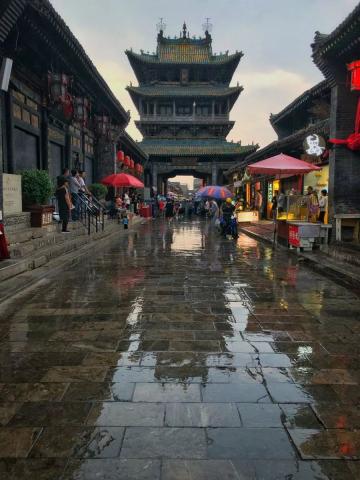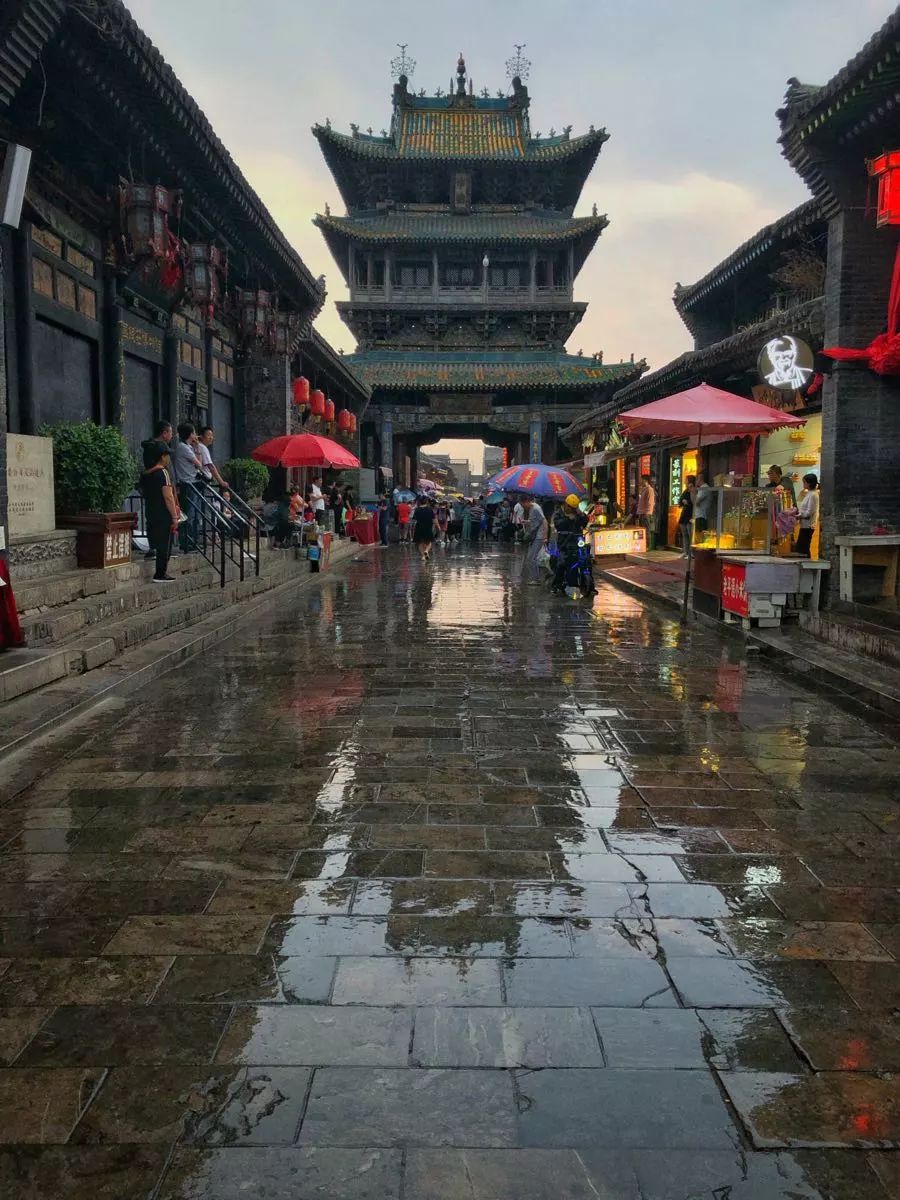
Last time I talked about Jinci Temple, this time I’m going to take a look at the city in Shanxi, of course the ancient city. Speaking of ancient cities, the first thing that everyone may think of is Fenghuang Ancient City and Lijiang Ancient City. Pingyao Ancient City, as the only ancient city in Shanxi Province, is the best-preserved ancient county in China (certified by Guinness World Records) and a world cultural heritage (only two places in China have successfully applied for the entire ancient city, the other is Lijiang ancient city). The ancient city of Pingyao has typical architectural features of the Ming and Qing Dynasties, which are extremely well preserved and fully demonstrate the cultural characteristics and residential communities of the Han nationality in China during the Ming and Qing Dynasties.
The introduction sign at the entrance to Pingyao Ancient City records that the city wall was first built in the Western Zhou Dynasty. After expansion and repairs in the Ming and Qing dynasties, it now has a total circumference of 6163 meters and a height of about 12 meters. This wall also separates Pingyao County into two parts. A world of different styles.

 We arrived at Pingyao Ancient City after lunch. Stay in a B&B in the ancient city.
We arrived at Pingyao Ancient City after lunch. Stay in a B&B in the ancient city. 

As a southerner, I was still a little surprised to see Kang again. The first time I saw a kang was when I was playing in a snow town in Northeast China many years ago. It was very comfortable to sleep on a warm kang in the snow town where the temperature was nearly minus 30 degrees Celsius. In the past, most people in the north slept on brick kangs, as many people know. I didn’t expect that we could sleep on the kang this time in Pingyao. This time it was summer, so there was no need to burn the kang. There was a kang table on the kang that was less than a foot high. We used to eat and do nühong (note: nühong, also called nvshi, in the old days) Refers to women's needlework, weaving, embroidery, sewing and other work and the finished products of these work), or men's writing and many other things are done on the kang. This time I made a pot of tea and drank it slowly while sitting at the Kang table while imagining the slow life of the ancients.

Pingyao Ancient City is an outstanding example of ancient Chinese cities during the Ming and Qing dynasties. Pingyao Ancient City has preserved all its characteristics. Moreover, in the development of Chinese history, it shows people an extraordinary complete picture of cultural, social, economic and religious development. (UNESCO World Heritage Committee)

After drinking tea, we couldn’t wait to see the ancient city.
First we went to Pingyao Ancient City Wall. The city wall was built as a rammed earth wall during the reign of King Xuan of the Western Zhou Dynasty (827 BC to 782 BC). It was rebuilt in the third year of Hongwu in the Ming Dynasty (1370), and the Pingyao city wall was covered with a layer of bricks on the basis of the original rammed earth city wall, forming the Ming Dynasty brick-and-earth mixed city wall that we see today, which is more than 600 years old. history. 




Coming down from the city wall and slowly entering the middle of the street, I found that there were many banknotes and merchants gathering on both sides of the street. Pingyao's spirit was due to Shanxi merchants, which also laid the seeds for the modern financial industry. This is the most prosperous street in the ancient city: South Street. There are many handicrafts, museums, clothing stores, snack bars...



Then go to the Rishengchang Bank located on West Street. This is known as the first bank account in China. It is famous for its ability to connect the world. It played a great role in promoting the development of commercial trade and modern industry in the late Qing Dynasty and the early Republic of China. Founder Lei Lutai. Historically, there were 51 ticket offices in the country, 43 in Shanxi, and 22 ticket offices in the small town of Pingyao. It is now a ticket office museum with the glorious history of a generation of ticket dealers. The Rishengchang Ticket Office and the Wei Tairan Ticket Office next to it are actually the same attraction. Enter from Rishengchang and exit from Wei Tairan.




Then we came to Pingyao Ancient County Government. Pingyao County Government Office is located in the center of Pingyao Ancient City. It was first built in the Northern Wei Dynasty and finalized in the Yuan, Ming and Qing Dynasties. The earliest preserved building was built in the sixth year of Yuan Zhizheng (1346), which has a history of more than 600 years. The entire government office faces south and has an axially symmetrical layout. The north-south axis is more than 200 meters long and the east-west axis is more than 100 meters wide. It covers an area of more than 26,000 square meters.
As one of the four well-preserved ancient government offices in China, Pingyao County Government Office is also the largest existing county government office in the country. The entire county government building complex is orderly, well-proportioned, and has a reasonable structure. It is an organic whole. On May 19, 2004, when the 11th Panchen Lama visited the county government office for inspection, he happily mentioned: "The ancient government office of Pingyao County" most".



Along the way, we also saw many courtyards with clear axes, left and right symmetry, and distinct levels. They are beautiful on the outside and beautiful on the inside. Along the central axis, there are several sets of courtyards. They are often divided by short walls and hanging flower gates in the middle to form two or three entrances. The basic layout form of the "日" and "目" characters. It is said that there are more than 400 such well-protected courtyard houses, which are a major feature of the ancient city.





These residential buildings remaining in Pingyao City are very well preserved and have both historical and cultural value, architectural art value, and practical value. They are still inhabited by urban residents today. This residential building complex well demonstrates the architectural community of the Ming and Qing Dynasties, which is dominated by brick-wood structures and cave-style buildings. Gorgeous paintings, exquisite wood carvings, vivid stone lions, rare screen walls, etc. abound, which is breathtaking. No wonder Pingyao is known as: "Treasure House of Cultural Relics and Pearl of the World", which is truly worthy of its name.
When we were tired from walking, we rested for a while in a coffee shop. After drinking a cup of coffee, the store was full of young people, and we were also old and chatting like teenagers. Drinking coffee in the ancient city gives you a feeling of traveling back in time.

Night slowly falls, and as the lights change, the ancient city takes on a different feel.


 At night, walking on the streets with only a few tourists, you can feel the feelings and style of Pingyao Ancient City. You will find that there are modern bars hidden under the antique buildings, but they are not like the noisy bars in big cities. Perhaps to cater to the trend of modern young people, they just put up modern billboards and slogans. . Sitting in this quiet bar with a few friends, sipping a glass of wine, chatting about recent events and moods, and listening to the stories in the songs of the resident singer is also a different kind of travel memory.
At night, walking on the streets with only a few tourists, you can feel the feelings and style of Pingyao Ancient City. You will find that there are modern bars hidden under the antique buildings, but they are not like the noisy bars in big cities. Perhaps to cater to the trend of modern young people, they just put up modern billboards and slogans. . Sitting in this quiet bar with a few friends, sipping a glass of wine, chatting about recent events and moods, and listening to the stories in the songs of the resident singer is also a different kind of travel memory.
